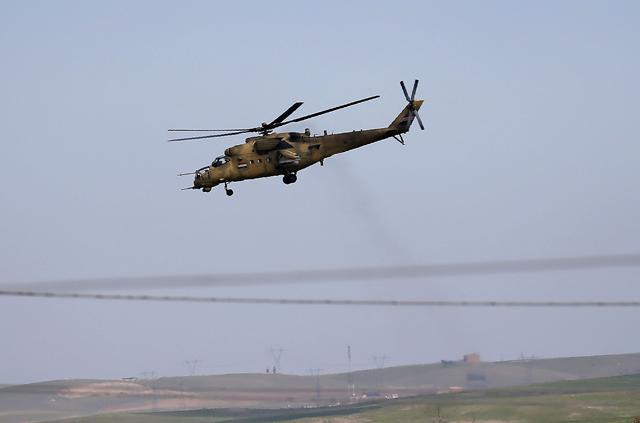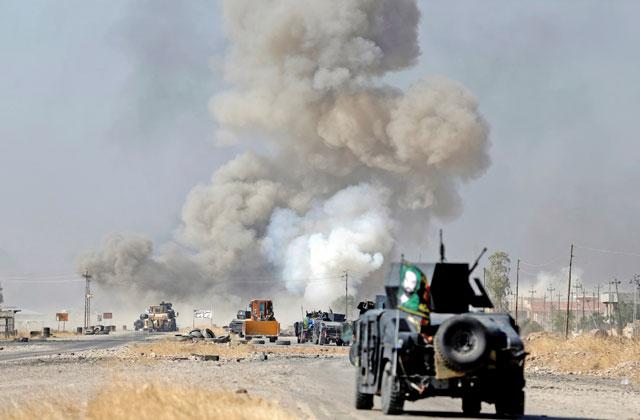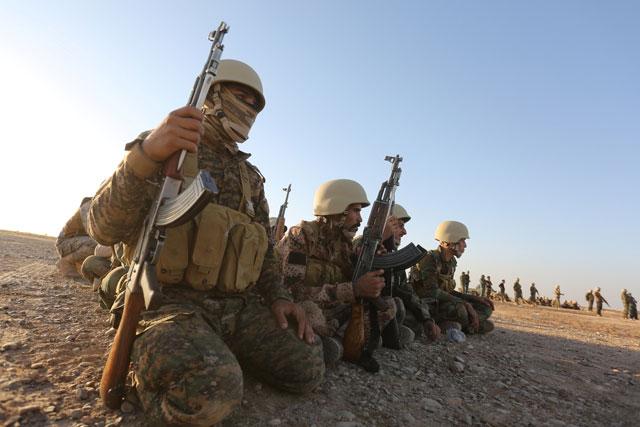You are here
Fighting from above: the air war on Daesh
By AFP - Nov 03,2016 - Last updated at Nov 03,2016

An Iraqi special forces soldier puts up a helmet as a decoy as a sniper gets ready to fire on Daesh positions in Gogjali, on the eastern edges of Mosul, Iraq, on Thursday (AP photo)
WASHINGTON — The Iraqi security forces' seemingly inexorable push towards Mosul saw fighting begin in the city itself this week, but it is work taking place in the skies above that has enabled such dramatic advances.
A relentless air operation using planes and drones from a dozen or so members of a US-led coalition against the Daesh terror group has over more than two years conducted some 16,000 air strikes against the extremists in Iraq and Syria — two-thirds of them in Iraq.
Mostly, coalition planes conducted "deliberate" strikes, where they destroyed targets acquired through intelligence or surveillance.
"Now, it's almost entirely dynamic strikes," a US military official told reporters during a recent visit to the Combined Air Operations Centre (CAOC), from where flights over Mosul and elsewhere are coordinated.
Dynamic strikes occur when ground units need air support on an unexpected target, such as an enemy fighting position or a car bomb being driven across the desert.
"The operation in Mosul is the number one priority right now," another US military official said.
Consider air activities in and around Mosul for just one day.
On Wednesday, coalition planes destroyed a Daesh headquarters building, five storage containers, two mortar systems, two fighting positions, a bomb-making factory, a supply cache, a sniper position, an observation post and a culvert.
The strikes also engaged two tactical units and damaged two tunnels, a bridge and a supply route, according to the coalition.
Air support is given to Iraqi security forces and Kurdish fighters, but not Shiite militiamen, and the Iraqi military has its own planes.
Three bullet holes
The coalition has enjoyed total air superiority in its anti-Daesh campaign. While planes have come under sporadic small-arms fire, the most significant damage was when a C-130 cargo plane took three bullets to its tail.
Officials worry extremists might seize "prestige" weapons such as surface-to-air missiles in the chaos that is neighbouring Syria, but so far this threat has not materialised.
Lacking military means, Daesh fighters use civilians trapped in Mosul as human shields to prevent strikes.
Daesh has also experimented with rudimentary air attacks, using hobby planes and toy drones to carry explosives. A military official said the extremists had experimented with a drone carrying a bottle containing some sort of chemical.
Thanks to this air domination, coalition planes constantly scout Iraqi and Syrian skies. The cost of the operation to date is almost $10 billion.
At any given time, 15-20 coalition aircraft — mostly drones — circle Mosul, creating a green "donut" on radar screens that pinpoint each plane's location with a small icon. Russian planes, which operate in the same air space over Syria, are yellow.
AFP was among a small group of journalists allowed into the CAOC, whose location can only be described as a "military base in Southwest Asia".
The centre is the primary hub for anti-Daesh air operations and coalition intel, and a never-ending stream of video from drones is beamed across eight huge monitors covering most wall space in the cavernous operations room.
One feed shows a small white pickup truck somewhere in Iraq. The drone's eye follows the vehicle into a compound, where a man loads something into the back.
The drone is 3,000 metres above but the footage is so clear he can be seen tucking his white shirt into his pants. The man's fate is unclear; a military official said he was likely a Daesh militant.
Even as the Mosul fight rages, officials are looking over to Raqqa in Syria as the next step in the campaign. Like they did in Mosul, the coalition has started hitting targets to "soften" areas in and around the city ahead of an assault.
The United States carries out most Iraq air operations, but Australia, Belgium, Canada, Denmark, France, Jordan, the Netherlands and Britain have between them launched more than 3,000 sorties there.
Iraqi security forces approaching Mosul grew accustomed to continual coalition air cover. But as the advance split along multiple axes, some units complained they were not getting enough air support.
"Because they didn't have folks right over the top of them, they didn't think we were going to be able to respond to them, when in fact we were able to," Air Force Lieutenant General Jeffrey Harrigian said, noting that a jet travelling at 645kph can quickly cover the entire Mosul area.
"Each time our partners on the ground required an air asset, we were able to support them, and we will continue to do that."
Related Articles
ERBIL, Iraq — The Daesh terror group shot down an Iraqi helicopter operating over Mosul on Thursday, as security forces announced they recap
EAST AND NORTH OF MOSUL, Iraq — The offensive to seize back Mosul from the Daesh terror group is going faster than planned, Iraq's prime min
TIKRIT, Iraq — Iraqi forces backed by air strikes from the US-led coalition gained complete control of the northern district of Shirqat on T



















